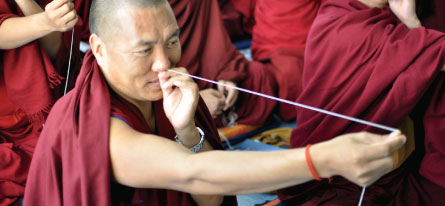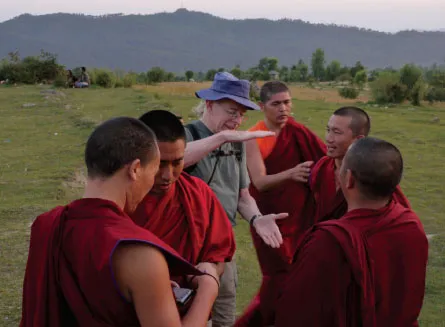Bringing science to Buddhist monks
As a senior staff scientist at the Exploratorium museum in San Francisco, Paul Doherty has taught kids, high school teachers and the audience of the Late Show with David Letterman about physics. But when he visited India last year, he had a different set of students: monks and nuns.


Doherty is part of Science for Monks, a program run by the Sager Family Foundation in Boston and the Library of Tibetan Works & Archives in Dharamsala, India. The two groups partnered after the Dalai Lama asked them to bring science education to exiled Tibetan monastic communities. In December, Doherty taught 18 monks and nuns who have completed their Tibetan monastic education. And this May, nine monks and nuns visited the Exploratorium to put on an exhibit called “The World of Your Senses” that delves into views of sensory perception.
“They are the best learners on Earth,” says Doherty, who has a Ph.D. in physics from MIT. “I was in awe.”
Doherty has a long-standing interest in education. In the 1970s, he started studying how computers could help students learn physics. After visiting the Exploratorium in 1982, he was so impressed by the science exhibits that he asked physicist Frank Oppenheimer, the museum’s founder, to hire him.
For Science for Monks, Doherty traveled to the College for Higher Tibetan Studies near Dharamsala, where he taught physics concepts such as relativity and the nature of particles. His lessons on perception often overlapped with Buddhist ideas and prompted challenging questions, such as whether the ink inside a red pen — where no one can see it — is still red.
His students also showed a playful side: During an exercise with a “telephone” made of two cups and a string, one monk dropped his iPhone into the cup and sent music to another monk. “When they learned something new, they were not shy about laughing out loud,” says Doherty. “For me, that was a joy.” — Roberta KwokExperiments to contemplate
Physicist Paul Doherty uses interactive exercises to teach science to Tibetan monks and nuns.
- Thermal energy To learn why thermal energy must be measured with a thermometer, one monk with cold hands and another with warm hands shook hands with an average-temperature monk. When asked if the average person’s hand was warm or cold, the two monks gave different answers.
- Scientific integrity The students stretched a string outward from their noses (above) and were asked what they saw. Some saw X’s, while others saw V’s or parallel lines. The lesson: Reporting truthful results is more important than getting the “right” answer.
- Perception The students looked at a bright point of light, which seemed to emit rays. But when the light source was blocked, the rays vanished; they are a trick of the eye and brain.